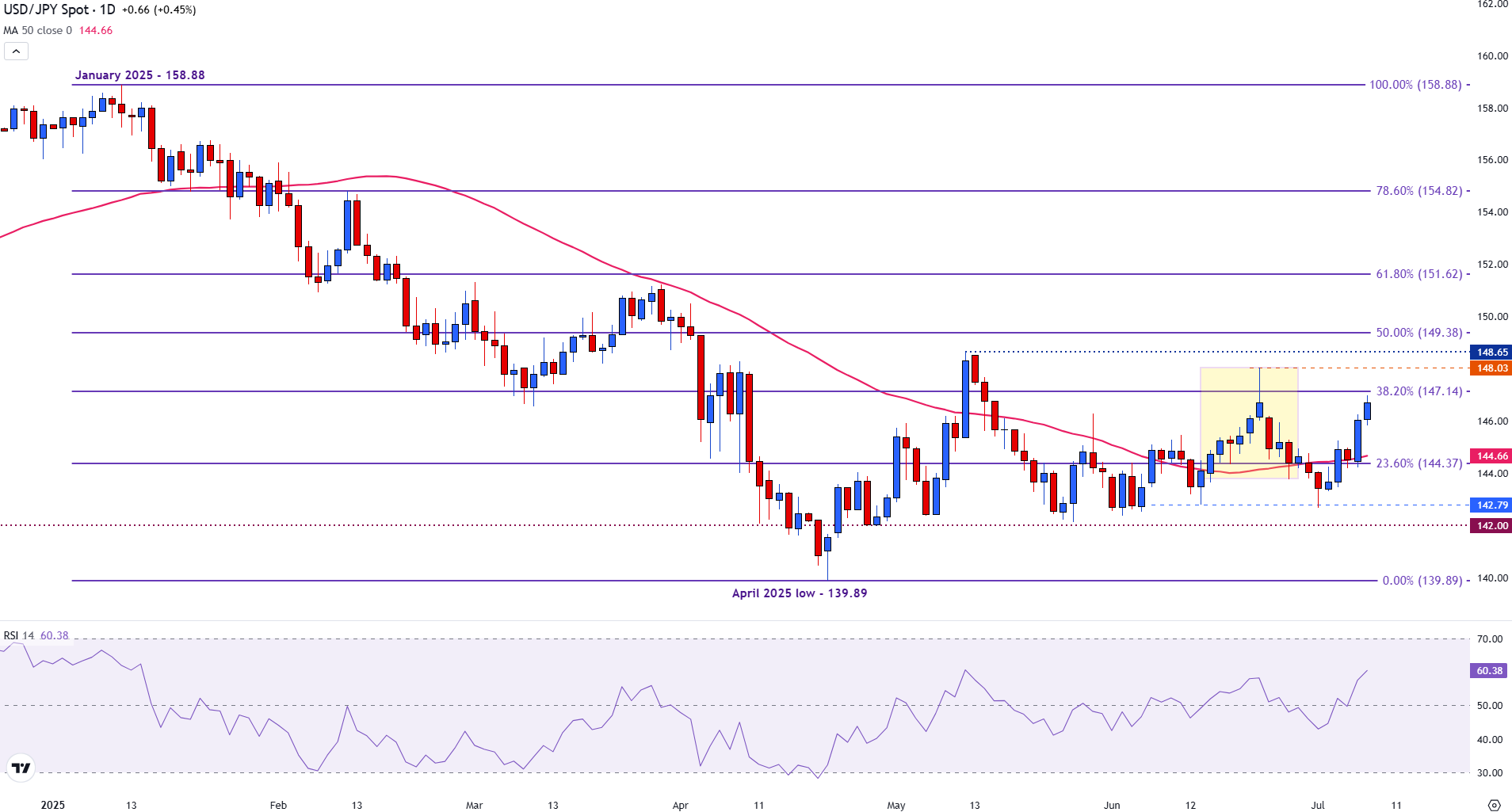Created
: 2025.07.09














![]() 2025.07.09 03:31
2025.07.09 03:31
The Japanese Yen (JPY) is weakening against the US Dollar (USD) on Tuesday as markets digest the latest tariff threats on Japan and weigh the potential prospects of a trade deal.
At the time of writing, the USD/JPY pair is trading 0.42% higher on the day, heading toward the 147.00 mark.
In a formal letter sent on Monday, the Trump Administration informed Tokyo that all Japanese imports will face a 25% tariff starting August 1.
Speaking at a conference in Tokyo on Tuesday, Japan's Prime Minister Shigeru Ishiba urged calm and reiterated Japan's commitment to keeping dialogue open.
At the same event, Japan's chief trade negotiator, Ryosei Akazawa, said, "The two countries must garner trust through sincere dialogue and reach common ground step by step. Through such a process, my job as negotiator is to agree on a full package as soon as possible."
However, Akazawa stressed that "There's no point striking a deal with the US without an agreement on automobile tariffs."
Automobiles from Japan to the US are already subject to a 25% tariff, while aluminum and steel imports face a 50% rate. As an export-driven economy, Japan is vulnerable to reduced demand from the US, which adds further pressure to its already fragile economic outlook.
In response, the Bank of Japan (BoJ) continues to pursue an ultra-loose monetary policy, maintaining interest rates at 0.5% since raising it in January. In stark contrast, the Federal Reserve (Fed) has held its benchmark rate between 4.25% and 4.50%.
The Minutes from the June Federal Open Market Committee (FOMC) meeting are due on Wednesday. This report offers a deeper insight into the Fed's stance on inflation, monetary policy, and potential future interest rate cuts. These details could help clarify the timeline for potential easing.
According to the CME FedWatch Tool, markets are currently pricing in a 62.9% probability of a 25-basis-point cut in September. If the Minutes shift those expectations, the resulting repricing could act as a catalyst for USD/JPY volatility.
From a technical standpoint, USD/JPY is approaching the 38.2% Fibonacci retracement level of the January-April decline, providing resistance at 147.14.
USD/JPY daily chart

A move above this level could see the pair retest the June high of 148.03, potentially opening the way for a retest of the May high at 148.65. The 50% Fibo level is at 149.38, a break of which could bring the 150.00 psychological level into focus.
The Relative Strength Index (RSI) is reading near 61, indicating strong bullish momentum without the pair being considered technically overbought.
However, if USD/JPY retreats, a break below 146.00 may allow bears to retest the 50-day Simple Moving Average (SMA) at 144.66, with the next big level of support at 142.00.
Tariffs are customs duties levied on certain merchandise imports or a category of products. Tariffs are designed to help local producers and manufacturers be more competitive in the market by providing a price advantage over similar goods that can be imported. Tariffs are widely used as tools of protectionism, along with trade barriers and import quotas.
Although tariffs and taxes both generate government revenue to fund public goods and services, they have several distinctions. Tariffs are prepaid at the port of entry, while taxes are paid at the time of purchase. Taxes are imposed on individual taxpayers and businesses, while tariffs are paid by importers.
There are two schools of thought among economists regarding the usage of tariffs. While some argue that tariffs are necessary to protect domestic industries and address trade imbalances, others see them as a harmful tool that could potentially drive prices higher over the long term and lead to a damaging trade war by encouraging tit-for-tat tariffs.
During the run-up to the presidential election in November 2024, Donald Trump made it clear that he intends to use tariffs to support the US economy and American producers. In 2024, Mexico, China and Canada accounted for 42% of total US imports. In this period, Mexico stood out as the top exporter with $466.6 billion, according to the US Census Bureau. Hence, Trump wants to focus on these three nations when imposing tariffs. He also plans to use the revenue generated through tariffs to lower personal income taxes.
![]()
Created
: 2025.07.09
![]()
Last updated
: 2025.07.09

FXStreet is a forex information website, delivering market analysis and news articles 24/7.
It features a number of articles contributed by well-known analysts, in addition to the ones by its editorial team.
Founded in 2000 by Francesc Riverola, a Spanish economist, it has grown to become a world-renowned information website.
We hope you find this article useful. Any comments or suggestions will be greatly appreciated.
We are also looking for writers with extensive experience in forex and crypto to join us.
please contact us at [email protected].
Disclaimer:
All information and content provided on this website is provided for informational purposes only and is not intended to solicit any investment. Although all efforts are made in order to ensure that the information is correct, no guarantee is provided for the accuracy of any content on this website. Any decision made shall be the responsibility of the investor and Myforex does not take any responsibility whatsoever regarding the use of any information provided herein.
The content provided on this website belongs to Myforex and, where stated, the relevant licensors. All rights are reserved by Myforex and the relevant licensors, and no content of this website, whether in full or in part, shall be copied or displayed elsewhere without the explicit written permission of the relevant copyright holder. If you wish to use any part of the content provided on this website, please ensure that you contact Myforex.
Myforex uses cookies to improve the convenience and functionality of this website. This website may include cookies not only by us but also by third parties (advertisers, log analysts, etc.) for the purpose of tracking the activities of users. Cookie policy